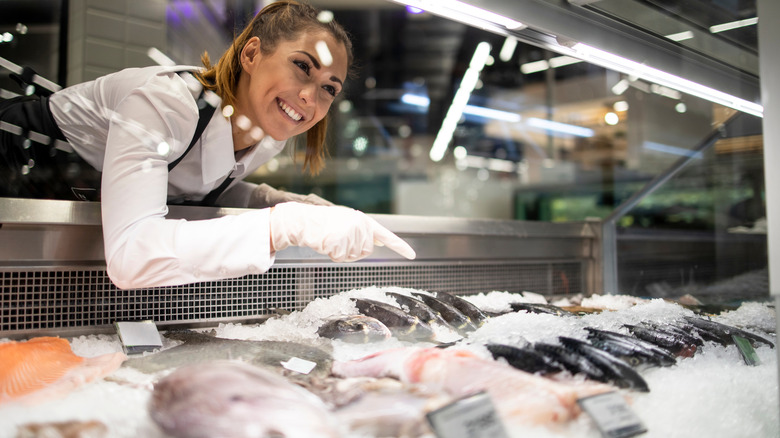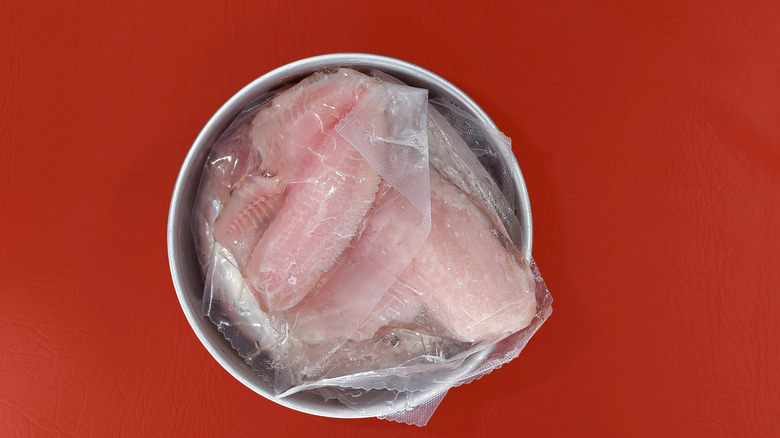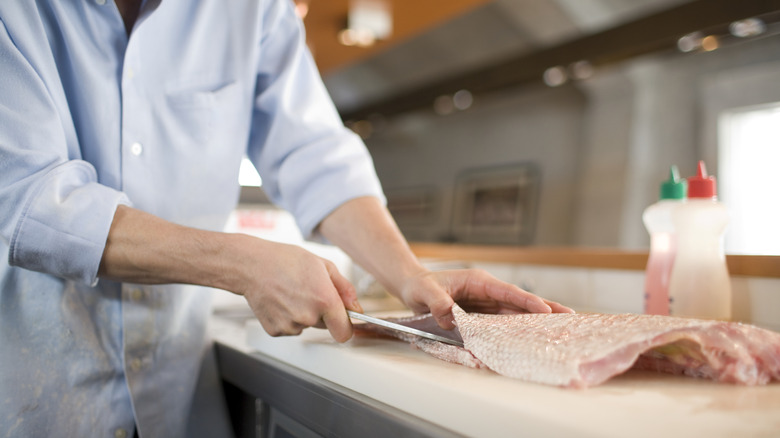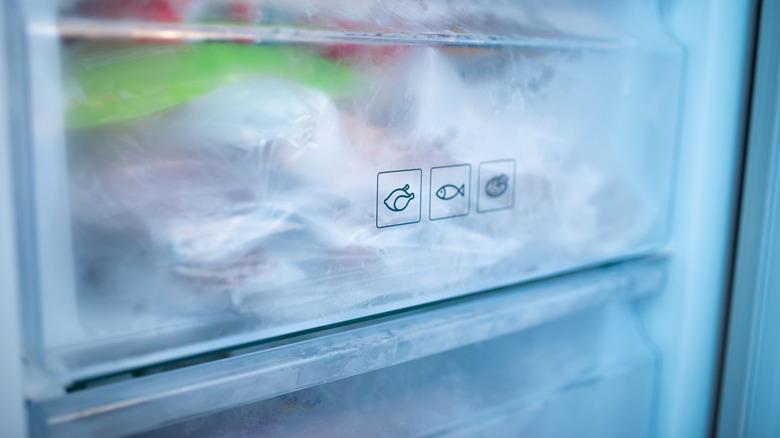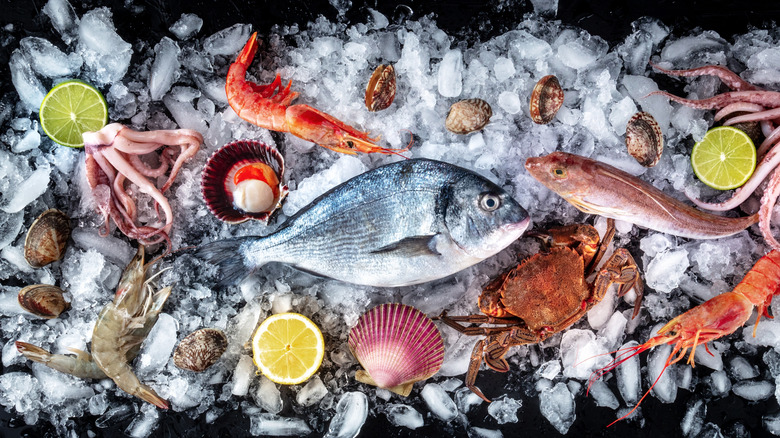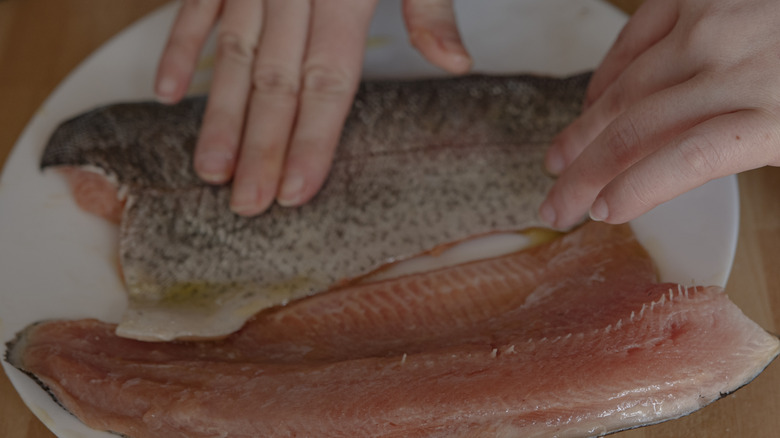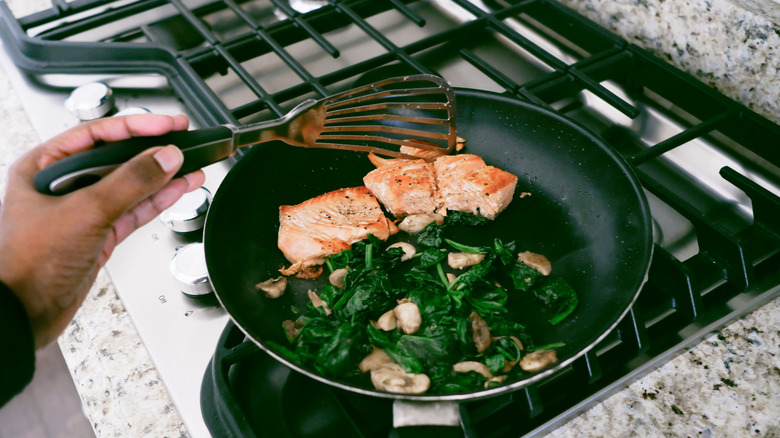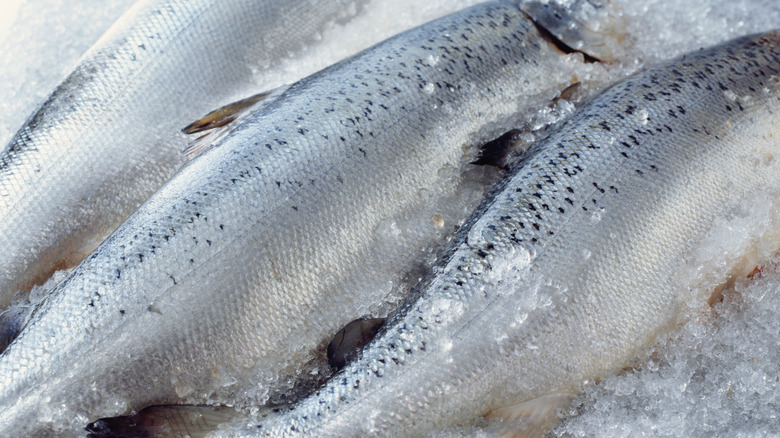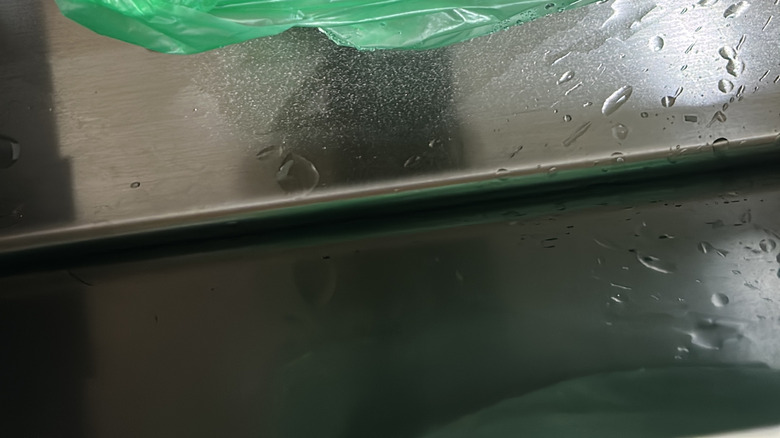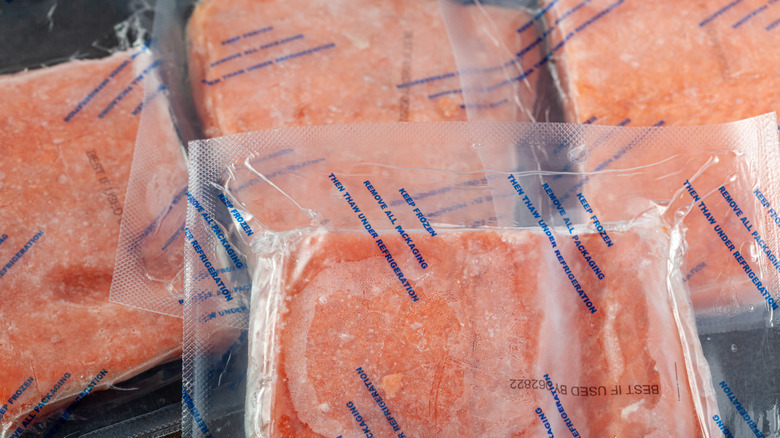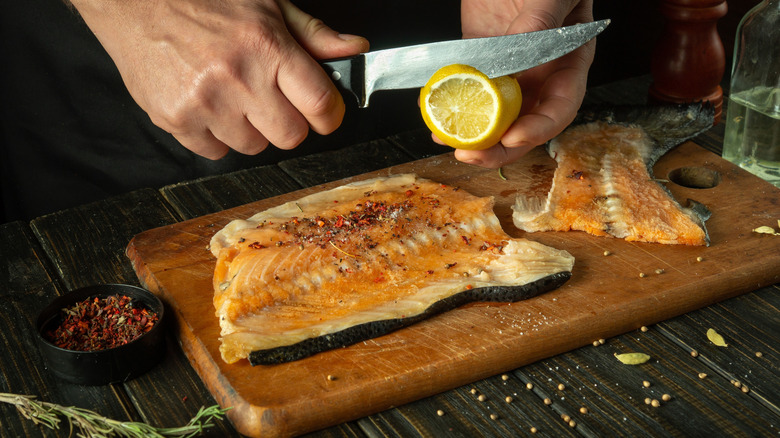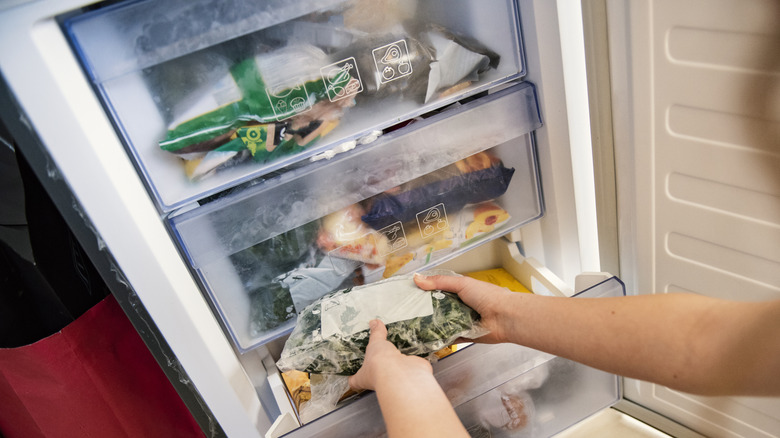12 Mistakes You Might Be Making With Frozen Fish, According To Experts
For those of us living in landlocked states, fresh fish isn't always accessible, and opting for frozen may be the best bet for your seafood cravings. Typically, fish should be labeled fresh or previously frozen at the store. Unless you live near a big fishing hub or port, fish that is marked "fresh" may be previously frozen and thawed out at the fish counter — despite the confusion that causes.
Before you go knocking frozen fish, you may not realize it can be both as nutritious and high-quality as it is when fresh. It all has to do with when the fish was frozen. If it's frozen at the peak of freshness, frozen fish can have the same texture and taste once thawed. In fact, a blind taste test in one study found that participants couldn't tell which scallops were fresh or previously frozen.
In that sense, frozen fish can be a great option to get high-quality seafood no matter your location or the season. However, there are some big frozen fish faux pas that you should avoid in order to make a successful dish. We spoke with chefs and seafood experts to uncover the biggest mistakes everyone makes when using frozen fish, and they provided tips on what you should do instead.
Trying to thaw fish too quickly
It can be tempting to try to quickly thaw your fish, but this is not only potentially dangerous from a food safety perspective, but it can compromise the protein. "Avoid running it under water to thaw if possible," said Michael Chavez, Kitchen Development Manager for Angry Crab Shack. "The delicate fish can start to break and lose shape."
The ideal way to thaw frozen fish is overnight in the fridge, according to Rima Kleiner, Registered Dietitian and Nutritionist at Dish on Fish. "The best way to do this is to cut a small hole in the vacuum-sealed packaging and place in a bowl or large baggie," she said. Then, stick it overnight in the coldest part of your fridge while it defrosts.
According to Kleiner, running your fish in sealed packaging under a steady stream of cold water (not warm or hot) can defrost your fish in up to 30 minutes. It might not require the full duration either. "Every 10 minutes check to see if [the] fish is thawing by pushing on [a] piece to see if it has some give," he added.
Defrosting at room temperature
You may be used to setting meat out on the counter to defrost. However, defrosting seafood at room temperature is a big no-no. "Unlike other proteins that hold their temperature a bit better — beef or pork, for instance — I would advise at-home chefs to stay away from thawing fish to room temperature on the counter," said Derick Wade, Executive Chef of The Darling Oyster Bar in Charleston. "When doing so, it is challenging to ensure the fish is kept at a safe temperature for consumption."
Bacteria grow quickly at temperatures above 40 degrees Fahrenheit, meaning your kitchen is likely not the best place to thaw your fish. And the longer your fish is out, the more bacteria grows. This bacteria development increases your risk for food poisoning, particularly scombroid poisoning — one of the most common fish poisonings that results in allergic reaction-type symptoms. This is common in fish that aren't properly refrigerated after being caught, particularly tuna, mackerel, mahi mahi, sardines, anchovies, herring, bluefish, amberjack, or marlin.
While you don't really have control over how the fish was stored before it got to your shopping cart, focus on what you can control and keep it at the appropriate temperature at all times — even when defrosting.
Keeping fish in the freezer for too long
While you can keep seafood in a temperature-controlled freezer indefinitely, it doesn't mean that you should. The United States Department of Agriculture says that frozen raw fish is best to consume within eight months, and the freezer temperature needs to be consistent at 0 degrees Fahrenheit or less. If you decide to keep it longer, it is still safe but you may notice the flavor and texture will be compromised the longer it is stored. If you cooked your fish already and are freezing leftovers, the recommended freeze time is under three months.
The vessel you use to freeze fish also makes a difference in how long it will last in the freezer. If the packaging loses its airtight capabilities, you will want to be sure to use that fish first and to do a "sniff test" prior to cooking. Careful freezer preparation is important for fish high in omega-3 fats like salmon or Chilean seabass, as they are prone to oxidation caused by air exposure. If the airtight bag becomes compromised, you will know due to the smell and "fishy" flavor.
Selecting the 'wrong' type of frozen fish
Whether all fish fares well in the freezer is up for much debate. While some say fattier fish holds its texture better in the freezing process than leaner fish, some experts say that proper freezing and handling when the fish is caught matters more than the fat content. "With today's advancements in processing and efficiency in transportation, all seafood is safe from a reputable supplier," said Michael Chavez.
Types of fish that can freeze well include salmon, tuna, trout, halibut, redfish or flounder. Other types that may lose flavor when thawed include catfish, bass, mackerel, or eel. It should be noted that these are still safe to eat, however, the potential downgrade in quality and flavor may inspire you to select afresh version over a frozen one.
Above all, you want your fish to be the freshest quality possible whether it's frozen or not. "The higher the quality of the protein, the better," said Derick Wade. This means you want to be mindful of what fish is currently in season to have an idea of the freshness of the frozen product.
Not patting your thawed fish dry
After safely defrosting frozen fish, there is an additional step to take before starting the cooking process. You will want to use a paper towel to pat your fish dry, absorbing any moisture from the thawing process. Otherwise, that excess moisture from the exterior may result in an unpleasant, mushy fish filet even after cooking. "Definitely try to thaw your fish overnight in the fridge on a paper towel-lined plate. This will absorb the moisture and keep the structure of the fish," said Michael Chavez. He also noted that it guarantees a crispier skin.
Drying off your fish will not only allow a seasoning or marinade to stick, but it also helps it get a good sear in the pan while keeping a moist, flaky texture inside. Even if you plan on leaving the skin on for cooking, patting your fish dry will keep that texture intact. Derick Wade said the thawing method is most important step when preparing fish, as all others follow from it. "Once the fish is properly thawed, I wash the fish off and then prepare it with seasonings, etc. as usual or as the recipe calls for," he said.
Losing fish's texture due to cooking technique
One of the best parts of frozen fish is the ability to customize the cooking technique you choose. However, consistency can be difficult, as can keeping your fish texturally intact. When deciding the best method to cook frozen fish, Derick Wade warns that your previously frozen fish may lose some texture and durability once it is thawed. "For frozen fish, I typically bake it because I have found that the fish is cooked in a more even manner, maintaining as much integrity of the protein as possible, whereas flipping, frying, etc. is a little harsher on the protein," he noted, adding that doesn't mean other cooking applications are off-limits.
Rima Kleiner suggested cooking fish directly from frozen in recipes like soups or stews for easy preparation, as "cooking from frozen makes it nearly impossible to overcook." She also pointed out: "Just keep in mind that it will require a longer cooking time than thawed fish. And also check that the fish is thoroughly cooked and the internal temperature reaches 165 degrees Fahrenheit."
If you have your heart set on cooking the fish from frozen, Wade said a sous vide bath is one of his tried-and-true methods. "Controlling the temperature of the water is much easier throughout the entirety of the cooking process rather than putting the protein directly in hot oil or a hot pan for example," he said. "Traditionally, this cooks the outside of the fish quicker than the middle."
Buying frozen fish that's not fresh
One of the most important factors when buying any type of food — but especially frozen seafood — is the freshness. Checking for freezer burn is important when buying frozen fish. While freezer burn doesn't necessarily mean that the seafood is unsafe, you may notice the quality is not up-to-par. "Frozen seafood varieties should not have white or dark spots or any discoloration," said Rima Kleiner. The discoloration can mean the fish has freezer burn, which also may look like an opaque white color in white-fleshed fish.
The packaging can be a tell-tale sign of how long the fish has been stored. "Avoid packages with signs of frost or ice crystals, which may mean the fish has been stored a long time or thawed and refrozen," said Rima Kleiner. The fish's texture can also be a giveaway that it's not as fresh as you'd like. "Frozen fish should not be bendable. Avoid packages where the 'frozen' fish flesh is not hard," she said, adding that packaging should not be open, torn, or crushed on the edges.
Where you source your fish can also have a big impact on whether it is fresh or not. "I advise purchasing your fish from a trusted source and personally lean heavily toward buying from a fish market or monger that uses sustainable practices when acquiring the fish," advised Derick Wade.
Thawing fish too early
Another big mistake you can make with frozen fish is leaving it out to thaw too early, forcing your hand on when you're having fish for dinner. The USDA recommends cooking or freezing fish within one to two days of being thawed in the fridge, as long as it stays under 40 degrees Fahrenheit. This time frame doesn't account for the thawing process in the fridge. So, if your fish doesn't make it to your plate by the first "thawed" day in the fridge, it is still safe to eat. However, you will want to be sure to cook the fish on the second day after being thawed to get the best quality and taste.
If fitting your meal planning into time frames has you stressed, defrost your fish the night before you plan to cook it (no earlier). That way, you have some flexibility with your meal planning since frozen fish can stay in the freezer for much longer periods than thawed fish in the fridge.
Incorrectly refreezing frozen seafood after thawed
We've all been there — you thaw your protein only to find out you won't be able to cook it in time or you've thawed too much. Rima Kleiner recommends avoiding putting previously frozen seafood that was thawed back into the freezer, as texture and taste quality will be impacted. However, freezing cooked seafood that has been safely thawed before preparing is okay.
Even though you may suffer some texture or taste issues, the USDA says raw food that has been thawed under refrigeration and chilled at 40 degrees Fahrenheit or below is okay to be refrozen from a food safety perspective. The key is that the fish needs to be handled properly throughout the time of purchase, transport, and in storage at home. Experts even recommend bringing a cooler bag to the store to keep the fish cold on the way home and ensure the temperature remains in the safe range at all times.
Incorrectly seasoning your fish
Since you are bringing frozen fish back to life by thawing it, use seasonings to help wake it up. Under or overseasoning fish can be the difference between a delicious dish or a fail. Your seasonings can be as simple as olive oil, salt, and pepper or a more flavorful marinade brushed on top. "Brush frozen fish filets with sauce, it freezes and turns into a glaze that melts into the fish as it cooks," suggested Rima Kleiner. Striking the appropriate balance between salt and acid is also key to a good seafood dish. "I love a good lemon butter application — the acidity is great and complements the protein very well," said Derick Wade.
Whether you select a dry rub seasoning or a marinade for your fish, experts warn against letting it sit longer than an hour. For salmon especially, a marinade can over-hydrate the fish and cause it to start getting mushy. Seasoning with salt too soon can also cause the proteins to start to break down and draw moisture out of the fish. To avoid this, season your fish of choice right before you plan to cook it.
Buying pre-cooked frozen fish meals
After all this talk of mistakes you can make in the process of cooking frozen fish, you may be scared off of starting from scratch and opt for a pre-cooked frozen seafood meal like fish sticks to heat up. That can certainly be more convenient, but you are also potentially sacrificing customization options and some of the health benefits that come from fish. Packaged or frozen food items are also notoriously high in fat, including trans fats, which can increase bad cholesterol (LDL) and lower the good cholesterol (HDL).
"If you are watching sodium intake or calories, opt for fish or frozen seafood meals that are [not] breaded, fried, or cooked in heavy sauces," Rima Kleiner suggested. "Instead, thaw the frozen fish and bread it or air fry yourself or make your own marinade or sauce so you control the ingredients." Buying pre-cooked seafood can also cause it to become overcooked when you reheat it. To avoid that outcome, experts recommend sticking with uncooked frozen seafood for more control.
How to best serve frozen fish
Once you select your frozen fish, the options for serving are endless. The versatility of seafood means you could use an Instant Pot, cook your fish in a skillet, or bake it on a sheet pan, according to Rima Kleiner. "Once thawed, you can do any cooking application you prefer. Grilling, pan-fried, baked, or even in a soup," Michael Chavez added. If you are looking for some inspiration on how to serve your frozen fish, our experts weighed in on their favorite methods.
Chavez suggested baking a fish like cod in a tomato white wine sauce. "Place your frozen cod loins in a baking dish with butter, cherry tomatoes, and fresh herbs in the oven at 375 degrees. When the cod is cooked to 145 degrees Fahrenheit, remove from the oven," he said. "Add the tomatoes and drippings from the pan into a saucepan with a splash of white wine. Reduce the sauce for several minutes. Pour the sauce over the cod loins for a very light and flavorful sauce that pairs well with the cod."
Meanwhile, Derick Wade suggested utilizing frozen fish in a stew or preparing tacos. "I would recommend staying away from crudos and ceviches for previously frozen fish, as these dishes are much, much better when using fish immediately after purchase," he said.
